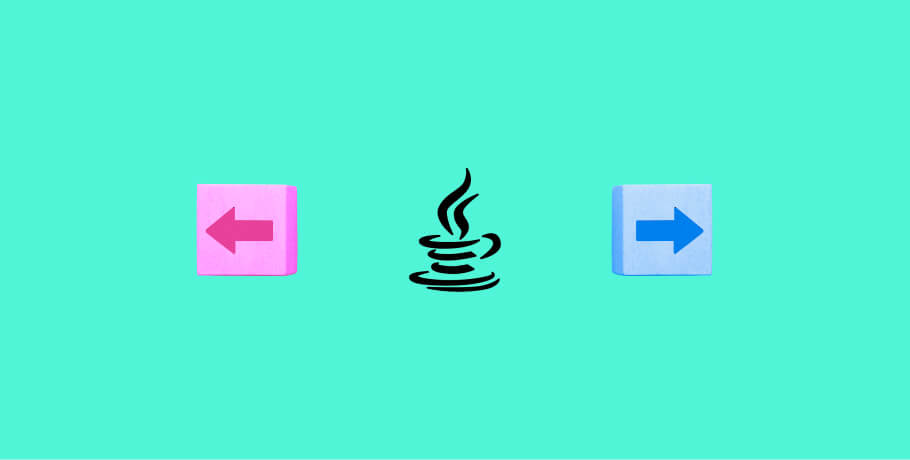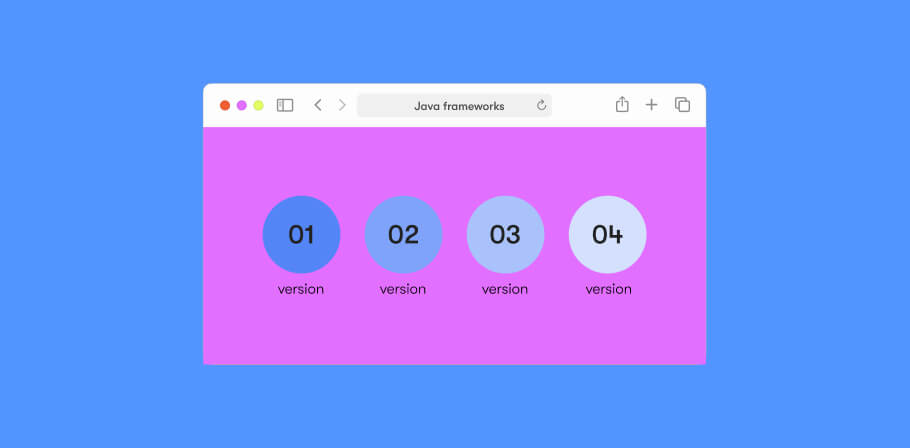Spring is a popular lightweight Java framework for building web applications. In recent years, its functionality has expanded globally. That's why when starting a new project, developers need to make much effort to configure it. And so, the Spring Boot framework was developed to avoid this time-consuming routine. As the name suggests, it is based on the Spring as mentioned earlier.
In this article, we will explain the main difference between Java Spring and Spring Boot, as well as find out in which cases it is better to use the first framework and in which cases – the second.
What is Spring?
Spring is an MVC framework for building enterprise-level web applications. It is based on Java, Kotlin, and Groovy. First launched in 2002, it was created to simplify the development of software solutions on the popular Oracle’s Java EE stack, which itself is quite complex and not convenient to use.
One of the main differentiators of Spring is its infrastructural support at the application level. Thus, developers can focus their efforts on building business logic without worrying about writing code to ensure compatibility with specific deployment environments. For example, Spring is not tied to a particular programming paradigm or model, so it can be used as a development framework for different applications.
The current version of Spring is 6.1.x released on November 16, 2023.
Main features
Spring is made up of many modules out of the box. Below we describe the main ones.
- Spring IoC. This module is responsible for the dependencies and configurations of individual components. It applies Dependency lnjection, taking these processes out of the creation of the object itself. Instead, objects are created in a unique method or constructor.
- Spring MVC. MVC is one of the most commonly used application patterns in which the program code is divided into three main parts: model (application data), view (interface and interaction with end users), and controller (logic responsible for responding to actions of end users). Thus, this module provides a clear and strict separation between architectural layers, simplifying developers' work.
- Spring AOP. AOP (Aspect Oriented Programming) is a paradigm often used in conjunction with Java, for example, for functionality that cannot be moved to separate entities using object-oriented programming. Therefore, this module simplifies the support of end-to-end functionality, allowing developers to describe it separately as an independent entity.
- Spring Data JDBC. Spring Data JDBC provides access to relational databases without using all the complexity of JPA (Java Persistence API) with its typical lazy loading, caching, and dirty tracking. In turn, Spring Data JDBC executes SQL queries if and only if the repository method is called.
- Spring Web Flow. Spring Web Flow is based on Spring MVC and allows Java developers to implement web application flows. The main advantage of this module is saving the states of web applications with controlled behavior.
- Spring Security. This built-in framework allows developers to create complex authentication and authorization mechanisms designed for projects of various sizes (including corporate ones with strict security policies).
- Spring Test. It is one of the modules that performs four main tasks: managing Spring IoC containers and caching them between tests, dependency injection for test classes, transaction management adapted for integration tests, and providing a set of base classes to streamline the creation of integration tests.
In fact, Spring has a much larger number of useful modules and built-in frameworks, which you can find on the official website of this software tool.
Use cases
It is most relevant to use Spring in the following cases:
- development of serverless applications and applications based on microservices;
- development of applications with high-security requirements on the server side;
- development of asynchronous software;
- creating an event-driven architecture;
- development of batches for process automation.
Benefits
Let's now discuss the main advantages of Spring.
- Versatility. Spring has several built-in components and technologies, allowing developers to use it comprehensively without having to pick up a large stack of third-party solutions. In particular, additional modules can be applied to the most relevant areas: web development, microservices, etc.
- Fast development. Compared to working with "pure" Java EE, this framework simplifies the tasks for developers and allows them to concentrate their efforts on creating business logic.
- Big community. Spring has well-researched documentation and a large community of developers from all over the world. Due to this, the framework is constantly being improved and supplemented with new solutions, which help optimize the process of writing code.
- Open source. Spring is free, which is relatively rare for Java-based solutions. Thus, the entry threshold for Spring is low, and it will not be difficult for you to find experts working with it.
Drawbacks
Now let's highlight some disadvantages of Spring.
- Time-consuming configuration. Working with Spring is more complex and longer than with Spring Boot, as Spring requires a lengthy configuration from scratch for each project. In turn, this takes more development time.
- The need for developers to have additional skills. Spring application development usually needs numerous XML configurations. This means that the requirements for developers become more extensive.
What is Spring Boot?
Being a framework extension to Spring, Spring Boot makes working with Spring much easier and faster, providing developers with a set of utilities that automate Spring configuration. In a nutshell, Spring Boot is not a tool for automatic code generation but a plugin (although often referred to as a framework) for a project build automation system.
Specifically, Spring Boot packages dependencies into starter packages, automatically configures applications with JAR dependencies and creates a web server that allows applications to run locally. The first version of Spring Boot was released in April 2014.
Main features
Every time a Spring project is created, developers must complete the following time-consuming steps:
- import the necessary Spring modules and the web container library (if development involves creating a web project);
- connect the necessary third-party libraries that are compatible with the version they work with;
- configure DAO components (data sources, transaction management, etc.);
- configure the components of the web layer (resource manager, view resolver, etc.);
- specify the class for loading the completed configurations.
To avoid these steps, they can use Spring Boot with built-in utilities which:
- automates the configuration procedures we mentioned above (even though developers may not always agree with the choice of default configurations, Spring Boot still always offers an effective module for solving a specific task);
- simplifies and fastens the creation and deployment of Spring-based projects;
- helps to manage dependencies and modules loading;
- automates the procedure of interaction with the built-in server;
- automatically creates and configures a database.
In general, the three most significant features of Spring Boot can be emphasized as dependency management, automatic configuration, and built-in servlet containers. In particular, to speed up the dependency management process, Spring Boot packages the necessary third-party dependencies for each type of Spring-based application and provides them to the developers through so-called starter packages. Then, after selecting the appropriate starter package, Spring Boot attempts to automatically configure the Spring application based on the JAR dependencies they added. And finally, thanks to this framework, the application runs itself, using the built-in server, as an executable JAR file.
Use cases
Spring Boot is best for building stand-alone digital solutions and production-ready Spring apps (including Java-based ones and web services). At the same time, this framework is not suitable for developing monolithic and large-scale software solutions. We will explain why below.
Benefits
The main advantages of Spring Boot are as follows:
- it can be used for the development of stand-alone apps;
- it speeds up and simplifies the development process as it doesn’t need XML configuration and WAR files deployment;
- it has a lot of production-ready tools and is easy-customizable;
- it allows developers to get rid of the boilerplate code (sections of code that need to be written in many places with minimal changes);
- it provides them with the opportunity to focus on the core business goals of the project they create.
All this is especially important in a microservice architecture when creating a large number of applications is needed.
Drawbacks
And now, for the objectivity of our overview, let's list the main disadvantages of this solution:
- it automatically generates numerous unused dependencies, which affect a considerable size of a deployment file and sometimes cause the application to be slow;
- the procedure of converting a legacy or existing Spring-based app to a Spring Boot one is complex and time-consuming;
- it isn’t the best option for the development of large-scale projects.
Configuration of Spring Boot and Spring
First, let's compare the configuration of Spring and Spring Boot to see how much easier it is to work with the second framework.
Spring
Let's see what the initial project configuration looks like in Spring:

Looks pretty heavy, doesn't it?
Spring Boot
Now let's see how all the above configurations in the case of Spring Boot can be placed in just a few lines of code:

Controlling of Spring framework and Spring Boot
To continue the Spring Boot vs. Spring framework comparison, we propose to consider the way of controlling in these two software tools.
Spring
Controlling of the Spring framework is based on the loosely coupled inversion of control, a software development principle that transfers control of objects or individual software modules to a container or infrastructure.
Unlike traditional programming, which tends to call the program code to libraries, Spring provides control over the flow of the project and the execution of calls to the program code responsible for the user side.
Spring Boot
In the case of Spring Boot, everything about controlling happens in the same way as in the case of Spring: the developer defines for the framework the objects necessary for accomplishing a task (for example, it can be providing a POJO to represent data). However, unlike Spring, project management is handled by this framework itself.
Security comparison of Spring Boot and Spring framework
A logical continuation of our Spring framework vs. Spring Boot comparison will be the analysis of the security of these two solutions.
Spring
The Spring framework contains the above-described built-in Spring Security framework, which is a set of servlet filters responsible for authenticating and authorizing end users through LDAP, JAAS module, Remember-me module, etc. In general, this set of features is enough to provide the necessary level of security for enterprise-level web applications.
Spring Boot
Spring Boot contains all the same security modules as Spring, but makes it easier for developers to work with dependencies. In particular, all dependencies related to the description of security mechanisms are implemented by adding Spring Boot Starter Security to the build configuration file (for Maven users, this is a pom.xml file, and for Gradle users, this is a build file).
Spring and Spring Boot: differences in scalability
Finally, it's time to discuss the Spring and Spring Boot differences in scaling.
Spring
Spring and JEE are the “gold-standard” solutions for building large-scale Java-based projects.
Spring Boot
Even though Spring Boot is a perfect option for creating microservices that can be deployed into Docker containers, this framework is still not recommended for developing large and monolithic software solutions.
Comparative table of Spring and Spring Boot
Still asking which is better and what to choose — Spring or Spring Boot? To help you with the answer to these questions, let’s take a look at this Spring vs. Boot comparison table:
Spring | Spring Boot |
provides a Dependency Injection feature | provides autoconfiguration |
doesn’t provide any server for testing (developers need to set it up manually) | provides embedded servers (such as Tomcat and Jetty) |
needs a lot of a boilerplate code | doesn’t require a lot of boilerplate code |
doesn’t provide an in-memory database | provides several in-memory databases |
doesn’t provide automation tools for defining dependencies | handles the dependencies automatically |
What types of projects does Spring suit the best?
Based on the above Java Spring Boot vs. Spring comparison, the following thesis appears: the latter is an ideal solution for developing web projects in Java using specialized modules and aspect-oriented programming. In particular, Spring is most often used to develop enterprise-level web applications.
When is Spring Boot the best choice?
With an understanding of the Spring Boot and Spring difference, we can conclude that Spring Boot helps to make the processes of app development, testing, and deployment more convenient. However, for large-scale applications, it’s not the best option.
Conclusion
We trust that our Spring vs. Spring Boot comparison helped you understand the difference between Spring Boot and Spring framework when it comes to web development, and now you know for sure which of these two solutions is best for your project. However, here is a short recap.
- Spring is the best choice for enterprise-level web apps with serverless, microservice-based and/or event-driven architecture, as well as apps with high-security requirements and/or asynchronous code;
- Spring Boot will be useful in stand-alone app development and for building production-ready Spring apps.
FAQ
For a better understanding of the key difference between Spring and Spring Boot in Java, let’s answer the most popular questions related to the topic of our article.

The EPAM Anywhere Editorial Team is an international collective of senior software engineers, managers and communications professionals who create, review and share their insights on technology, career, remote work, and the daily life here at Anywhere.
The EPAM Anywhere Editorial Team is an international collective of senior software engineers, managers and communications professionals who create, review and share their insights on technology, career, remote work, and the daily life here at Anywhere.
Explore our Editorial Policy to learn more about our standards for content creation.
read more


















